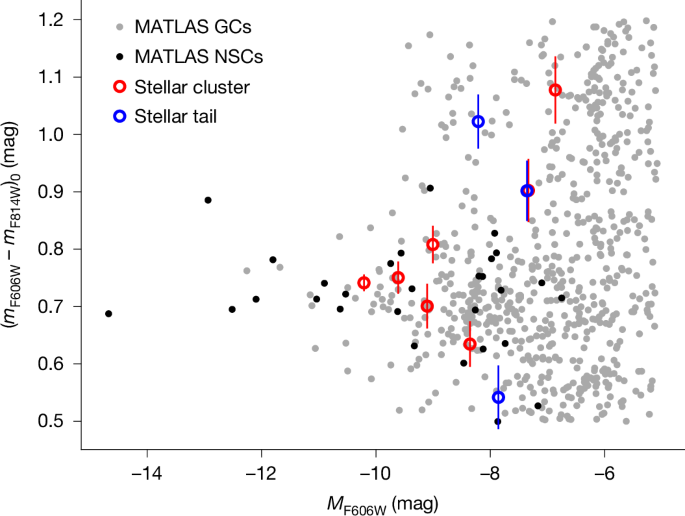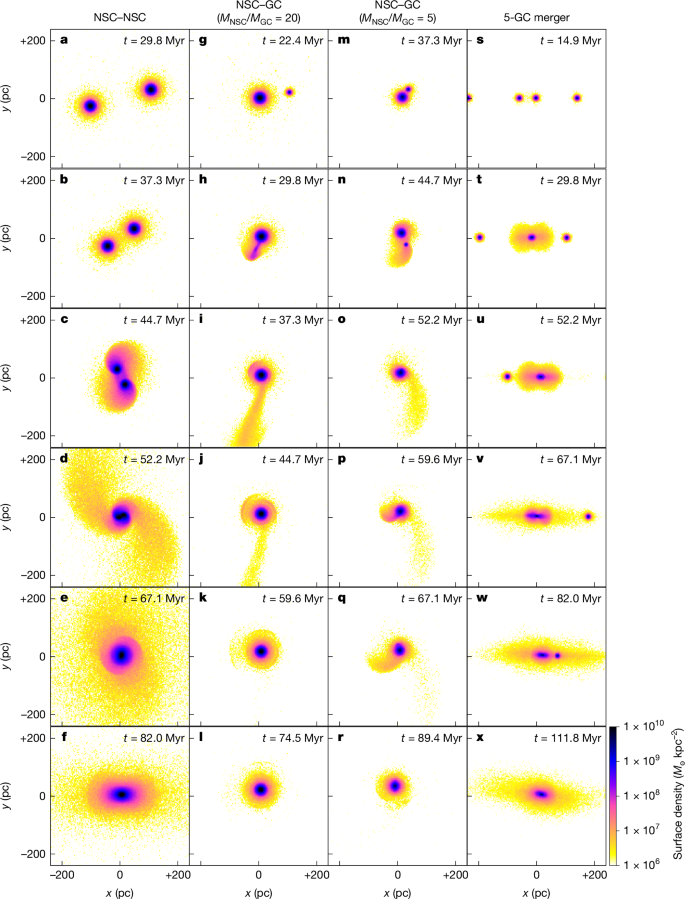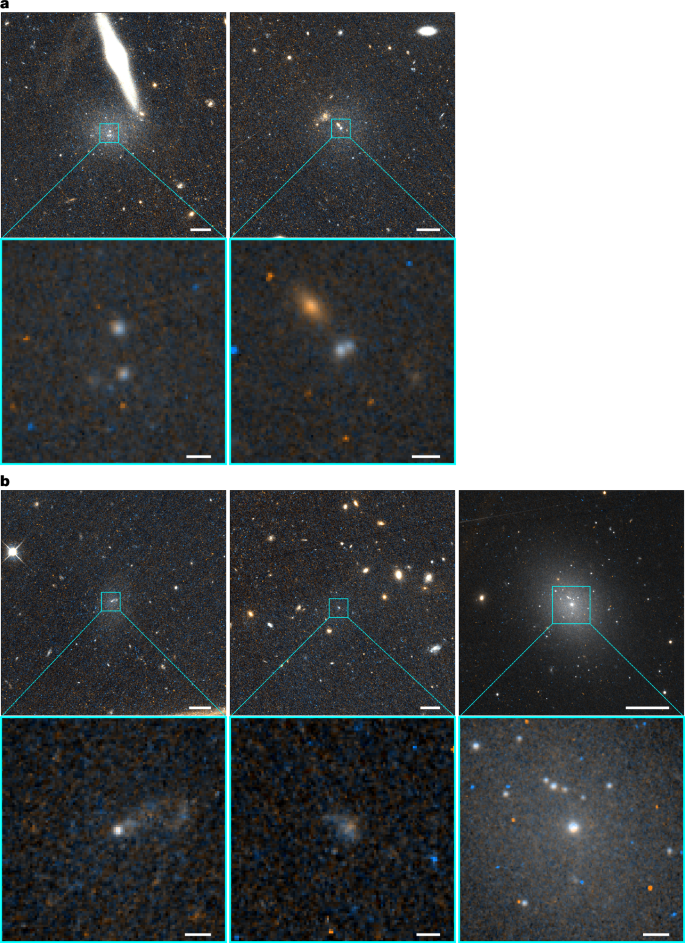Witnessing the formation of nuclear star clusters (NSCs) is important to fully understand how these extremely compact and massive objects can form at the centre of a wide range of galaxy types. NSCs, typically, have a stellar mass M* in the range of 105–108M⊙ and an effective radius Re up to several tens of parsecs (ref. 10). Over the past decades, two main scenarios have been put forward and are debated to explain the formation of NSCs.
In the in situ formation scenario3, the infall of gas triggers star formation and forms an NSC. This scenario is favoured in massive galaxies and predicts the presence of two compact sources: a massive black hole or a star cluster surrounded by a stellar disk and a compact object formed from stars gathering at the disk apoapsis. This is observed in the nuclear region of the Andromeda galaxy11 and has been reported in several other galaxies12,13,14.
Alternatively, NSCs could form from the infall of GCs due to dynamical friction4. This migration plus merging scenario is suggested to dominate in dwarf galaxies. Observational signatures of this scenario include the presence of multiple star clusters15,16,17 and tidal interactions in the inner regions, possibly leading to the formation of tails. However, no direct observation of tidally interacting and merging star clusters near the centre of dwarf galaxies has been reported so far in the literature.
The study of the stellar population alone is often not enough to differentiate between the two scenarios. Young stellar populations, in particular, can result from either formation scenario or a combination of the two. An example of this combination is the wet-merger scenario18, that is, the formation of an NSC from the migration of a star cluster together with a gas reservoir. Thus, these studies need to be coupled with high-resolution observations to fully reconstruct the formation steps of NSCs.
An NSC growth scenario is possible by involving interacting galaxies. In the stages of a merger between two nucleated galaxies, multiple nuclei should be visible in the central regions of the galaxies, as observed in several systems19. The nuclei will eventually end up merging to form the NSC of the galaxy remnant. A clear sign of ongoing or past galactic collisions is the presence of an overall boxy shape of the galaxy remnant, or tidal tails and shell structures in its outskirts.
High-resolution optical images of a sample of 79 dwarf galaxies were recently obtained with the Hubble Space Telescope (HST) as part of follow-up observations of nearby galaxy satellites from the Mass Assembly of Early-Type Galaxies with Their Fine Structures (MATLAS) survey (Methods). Most of the selected galaxies for the HST follow-up have a lower surface brightness and a larger size than typical dwarfs and can be defined as ultra-diffuse galaxies20 (UDGs). The HST sample covers about 65% of the MATLAS UDG sample21, and apart from their size and surface brightness criteria, UDGs have similar structural properties compared with dwarfs. Among the galaxies observed with HST, 10 exhibit a nucleus with substructure, such as multiple star clusters and stellar tidal tails. We note that bright sources are observed on the deep ground-based MATLAS images at the location of the complex nuclear systems revealed by the high-resolution HST images (Extended Data Figs. 1 and 2). This excludes the possibility that these nuclear substructures are instrumental artefacts.
To check whether the observed nuclear substructures are signatures of the migration scenario, that is, the predicted formation process for the nucleus of dwarf galaxies, we isolated a sample of dwarfs whose nuclear structures probably formed from internal mechanisms and whose luminosity and colour are consistent with NSCs and GCs from the MATLAS survey (Methods). Therefore, we removed four dwarf–dwarf merger candidates (Extended Data Fig. 2) and excluded one NSC that might be experiencing a wet-merger scenario given the blue colour of some structures of its nucleus (Extended Data Table 1). Hence, we are left with a sample of five galaxies. A colour–magnitude diagram of their substructures is shown in Fig. 1.
We computed the detection rate of interacting–merging nuclei in our specific sample of dwarfs observed with the HST. Of the whole initial sample, only 13% (10/79) show a complex nuclear region. Moreover, the fraction decreases to 7% (5/74) when we exclude the dwarf–dwarf merger candidates and to 4% (3/74) if we focus only on the least ambiguous sign of a star cluster merger—tidal tails. This detection rate might be higher than that of typical dwarfs because the low central surface brightness of our galaxies makes the detection of tidal tails easier. Thus, observing complex nuclei, and especially tidal tails, is rather rare and requires a large sample of low surface brightness dwarfs.
To investigate the origin of the nuclear stellar tails, we compared our observations with the results of collisionless N-body simulations of NSC–NSC, NSC–GC and GC–GC mergers. We explored the effect of the simulation parameters—for example, the impact parameters, radial velocity, tangential velocity or mass ratio—on the merging process. Based on the average properties of NSCs in the MATLAS dwarfs observed with HST (M. Poulain et al., manuscript in preparation) and the properties of the Milky Way and the Andromeda galaxy GCs22,23, we used an initial stellar mass M* = 106.5M⊙ and 105.2M⊙ for NSCs and GCs, respectively. Further details on the simulations can be found in the Methods. In Fig. 2, we show the main observed effects of these parameters on the different types of simulation. Our results indicate that overall, the merger of two star clusters can occur on short timescales, typically within a maximum of 50 Myr from first contact between the clusters to complete coalescence. We note the clusters must collide for the merger to happen on these short timescales. If the tangential or radial velocity is high enough so that they do not make contact, then they would orbit past each other without creating any features, and perhaps never merge.
a–f, An NSC–NSC merger with non-null tangential velocity. g–l, An NSC–GC merger with a mass ratio 1:20. m–r, A 1:5 NSC–GC merger. s–x, a 5-GC merger. Assuming a stellar mass-to-light ratio of 7, a surface density of 3.1(1.2) × 106 M⊙ kpc−2 translates in a surface brightness of 27(28) mag arcsec−2 (r-band filter).
The merger of clusters of similar mass (1:1), that is, two NSCs or two GCs, induces the formation of an extended elliptical nucleus without a long and extended tail, as represented in Fig. 2a–f. When the merger involves more than two GCs, as shown in snapshots Fig. 2s–x, the larger the number of clusters, the longer the extension of the final remnant nucleus. Moreover, an S-shape structure can be visible for a few tens of Myr when a non-null tangential velocity is applied to the colliding cluster, as observed in Fig. 2c,d.
An NSC–GC merger, or a merger of star clusters with mass ratios of at least 1:5 or greater, produces extended stellar tails together with shell structures around the newly formed NSC. A 1:20 and 1:5 merger are represented in snapshots Fig. 2g–l and Fig. 2m–r, respectively. Assuming an old red stellar population in the clusters and a detection limit of 28 mag arcsec−2, tails are visible for about 30–40 Myr. Shells at that surface brightness or brighter remain for a longer time (45–90 Myr). However, the detailed structures of the shells are more likely to appear diffuse at the resolution of HST, making them more difficult to identify in our observations.
The length of the tidal tail depends on the difference of mass between the two clusters, in which the larger the mass ratio, the longer the tail. For example, the maximum length of the tail changes from about 480 pc for a 1:20 mass ratio to only 275 pc for a 1:5 mass ratio. Moreover, in the case of small mass ratios (MNSC/MGC = 5), we observe the apparition of a smaller secondary tail, as seen in Fig. 2p,q.
We note that a tangential velocity of 2 km s−1, or less, did not affect the overall morphology of the NSC–GC mergers. However, for a 1:20 ratio and a tangential velocity similar to the galaxy circular velocity (here 5 km s−1), multiple pericenter passages are necessary before the merger occurs, each of them producing a very short lasting (about 7.5 Myr) and small tail (around 100 pc at 28 mag arcsec−2), whereas the merger produces a longer tail (up to 250 pc) visible for about 38 Myr at 28 mag arcsec−2.
We further investigated the effect of the stellar and dark-matter components of the host galaxy on the formation of the tidal tails. The use of a cuspy halo or more massive disk slightly shortens the timescale on which the merger happens compared with our fiducial dwarf galaxy model, because of increased dynamical friction. But it has only a mild impact on the duration for which the streams will be visible. We observe that the tidal tails last up to 60 Myr at 28 mag arcsec−2 when using a 10 times more massive stellar disk. This suggests that the detection rate should increase with the stellar mass of the galaxy. However, we find that the tidal features, with their low surface brightness, will be more easily hidden by the intrinsic brightness of the higher surface brightness dwarfs, and thus be more difficult to detect in a typical dwarf than in UDGs. Overall, a change in the stellar or dark-matter components does not seem to have a huge impact on the general shape of the created tidal tails, and although the features will be longer detectable with the former, the timescales are still short, less than 100 Myr.
Comparing the results of the photometric study of the central parts of the dwarf galaxies with the simulations allows us to reconstruct the two main steps of the migration scenario: the infall and merger of star clusters (Fig. 3). We observe a possible migration of massive GCs towards the galaxy centre of MATLAS-138 and MATLAS-987. Furthermore, given the bright nuclei and the large extent of the tails in MATLAS-207, MATLAS-1216 and MATLAS-1938, we probably witness the merging of two star clusters with a notable mass difference, such as NSC–GC mergers. Moreover, observations and simulations concur to highlight the rarity of detection of these complex nuclei, as suggested by the computed low detection rate and the short timescales of this formation channel. We also expect to see fewer tidal tails than star clusters in the nuclear region given their low surface brightness and the fact that they are only produced when the merger occurs between the star clusters. Therefore, large surveys of low surface brightness dwarf galaxies with deep and high-resolution images are required to observe these processes. We expect to find similar structures in upcoming large space telescope surveys, such as the Euclid Wide Survey24.
a,b, The sequence starts with the migration of massive GCs towards the galaxy centre (a), as seen in the two double-nucleated dwarfs MATLAS-138 and MATLAS-987, followed by a GC–NSC merger that exhibits tidal tails (b), as in MATLAS-207, MATLAS-1216, and MATLAS-1938. We show 1′ × 1′ and 5″ × 5″ HST F606W and F814W colour-composed cutouts of the galaxies and their nuclear region, respectively. The magnification on MATLAS-1938 nucleus is of 10″ × 10″ to highlight the elongation of the stellar tail. Scale bars, 1 kpc (a, top; b, top); 100 pc (a, bottom; b, bottom).





